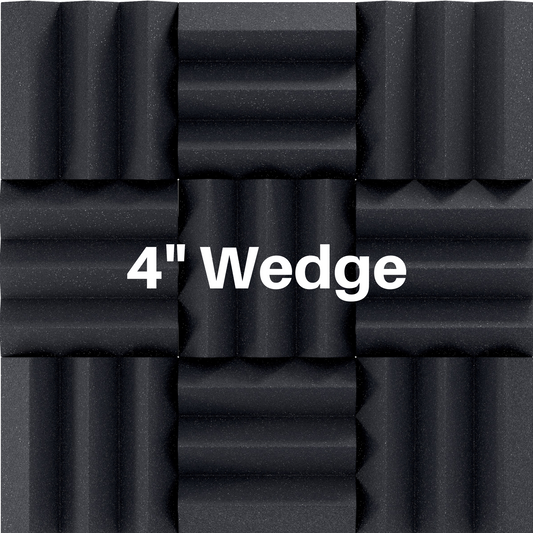What is sound absorption?
Share
Sound absorption is the process by which sound waves are absorbed by a material and converted into heat or another form of energy, rather than being reflected back into the room.
When sound is absorbed what does it change into?
When sound waves come into contact with a material, some of the energy of the waves is dissipated as heat, which causes the sound to become quieter.
Materials that are good at absorbing sound are often used in environments where noise reduction or acoustic control is important, such as in recording studios, concert halls, or offices. Common examples of sound-absorbing materials include acoustic foam, rockwool insulation, fiberglass insulation, and polyester felt.
How does sound absorption affect a room?
A room's sound is primarily determined by the absorptive qualities of its surfaces and objects within the room. When sound hits an absorptive surface, it is not reflected back into the room but instead may be converted to heat or physical vibration, or it may escape the room entirely.
A common misconception is that materials that absorb sound can also prevent sound from traveling between spaces, which is not true. In fact, materials that are effective at absorbing sound are typically soft and porous while materials that block sound are often dense and thick.
Sound Absorption vs Soundproofing
Sound absorption and soundproofing are two different concepts in acoustics that serve different purposes.
Sound absorption refers to the ability of a material or surface to absorb sound waves and convert them into heat or other forms of energy. This reduces the amount of sound that reflects back into the environment reducing echoes, reverberation, and overall noise levels.
Soundproofing, on the other hand, is the process of preventing sound from entering or leaving a room. Soundproofing involves blocking or reducing the transmission of sound waves through the use of sound barriers which are often thick and dense material. Soundproofing is typically used to create a quiet environment by preventing outside noise from entering a space or by preventing noise from escaping a space. Learn more about soundproofing HERE.
What materials are sound absorbing?
There are many materials that are effective at absorbing sound, including:
- Acoustic foam: specially designed foam that is made of open-cell polyurethane foam or melamine foam, which is excellent at absorbing sound waves.
- Fiberglass insulation: fiberglass batts like Owens Corning 703 are a popular choice for DIY acoustic panels.
- Acoustic ceiling tiles: these tiles are made of mineral fiber or fiberglass and are designed to be installed on ceilings to absorb sound and reduce noise levels. These are very popular in schools and office buildings inside drop ceilings.
- Fabric panels: these panels use acoustically transparent fabric on the surface and a core of rockwool or fiberglass insulation to absorb sound. These are popular DIY panels.
- Felt polyester panels - these panels are made of recycled polyester and are great for absorbing high frequencies and eliminating echoes.
- Natural materials: certain natural materials such as cork and cotton can also be effective at absorbing sound.
It's important to note that the effectiveness of a material at absorbing sound depends on its thickness and other characteristics. Make sure to check the materials absorption ratings to make sure it is what you need!
Additionally, the placement of the material in a space can also affect its effectiveness. For optimal sound absorption, it's best to consult with an acoustics professional or engineer to determine the best materials and placement for a particular space.
Schedule a consultation HERE!
These types of materials discussed so far are examples of porous absorbers. There are also other types of acoustical absorbers.
Panel absorbers: (aka flexural or diaphragmatic absorbers) These devices consist of non-porous panels that are separated from a surface so there is an air cavity in between the surface and the panel. These panels flex at their resonant frequencies to convert the sound energy to heat. These absorbers are effective for only a single octave.
A resonant absorber: (aka Helmholtz resonator) These acoustical devices use air cavities within a material to resonate at certain frequencies to convert sound energy to heat. An example of a popular resonant absorber is a cinder block used in gymnasiums. The air gap in the cinder block resonates to help absorb crowd noise during games.
Does sound absorption depend on frequency?
Yes, sound absorption does depend on frequency. The effectiveness of a material at absorbing sound waves depends on the frequency of the waves, as well as the physical properties of the material.
Generally, high-frequency sound waves (above 2000 Hz) are easier to absorb than low-frequency sound waves (below 250 Hz). This is because high-frequency sound waves have a shorter wavelength and are more easily absorbed by thinner materials. Low-frequency sound waves have longer wavelengths and require thicker materials to be absorbed effectively.
The absorption coefficient of a material, which is a measure of how much sound energy is absorbed by the material, varies with frequency. Manufacturers typically provide absorption coefficient data for a range of frequencies to help designers and acousticians select appropriate materials for specific applications. This brings us to our next topic. How sound absorption is measured.
How is sound absorption measured?
The absorption coefficient is a property of a material that indicates how well it absorbs sound waves. It is a measure of the amount of sound energy that is absorbed by a material. The absorption coefficient is a ratio and is typically denoted by the symbol α (Greek letter alpha).
For example, if 4W of sound power were to be directed at a surface that absorbs 2W, the absorption coefficient would be 0.50.
The absorption coefficient is a ratio meaning it has no unit associated with it. The absorption coefficient ranges from 0, which means a surface is completely reflective, to 1, which indicates a surface that is fully absorptive. Sometimes you see ratings above one which means the surface is fully absorptive.
Here is an example of our wedge acoustic foam absorption ratings. Our panels were tested by Riverbank Acoustical Labs in Illinois.
The absorption ratings of materials vary depending on their thickness. For reducing occasional echoes, one-inch thick panels may suffice. However, in spaces like recording studios or home theaters where a flat frequency response is desired, low-frequency absorption, such as bass traps, must be taken into consideration
The Noise Reduction Coefficient, commonly known as the NRC for a material is simply a measure of how much sound, or acoustic energy, a material can absorb. This is the average of all the other values.
The NRC will be in decimal format. For example, let's say a material has an NRC of 0.40. What we are saying is that the material absorbed 40% of the acoustic energy and the other 60% reflected back or passed through.
Sound Absorption vs Reflection vs Diffusion
Reflection - Sound bounces off a surface. This occurs on flat and hard surfaces like drywall, hardwood floors, concrete and brick. The sound wave is deflected because it cannot penetrate or pass through the material. This creates echoes.
Absorption - Sound is absorbed by soft and porous materials like acoustic foam, an area rug, curtains etc. When a sound wave comes in contact with an absorptive material the sound energy is converted to a small amount of heat energy causing the sound to decay much faster.
Diffusion - When a sound wave hits an uneven surface like a bookcase or acoustic diffuser, the wave breaks up and is scattered. The scattered sound waves have much less energy per wave and will decay faster than a reflected sound wave.

The sound waves that are not reflected back into the room are either diffused by the diffuser, absorbed by the absorber, or pass through the boundary and onto the other side.
Sound Absorption Examples
Sound absorption is used in many real-world scenarios to reduce noise levels and improve the acoustic environment. Here are some examples:
Recording Studios: Recording studios use sound-absorbing materials such as acoustic panels and foam to create a controlled acoustic environment where sound can be recorded without unwanted echoes or reflections.
Theaters: Theaters use sound-absorbing materials on walls, ceilings, and floors to improve sound quality and prevent sound from bouncing around the room.
Office Buildings: Open-plan office spaces can be very noisy due to the high number of people talking and moving around. Sound absorbing materials such as acoustic ceiling tiles and carpeting can help reduce noise levels and create a more comfortable work environment.
Schools: Classrooms and lecture halls can be very noisy, making it difficult for students to concentrate. Sound-absorbing materials such as acoustic panels and ceiling tiles can help reduce noise levels and improve the learning environment.
Restaurants: Restaurants can be noisy due to the sound of people talking and the clatter of dishes and cutlery. Sound-absorbing materials such as ceiling tiles and wall panels can help reduce noise levels and create a more pleasant dining experience.







